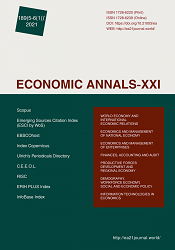The energy efficiency of the national economy assessment in terms of investment in green energy
The energy efficiency of the national economy assessment in terms of investment in green energy
Author(s): Olim T. Astanakulov, Khurshid S. Asatullaev, Nodira I. Saidaxmedova, Nilufar BatirovaSubject(s): National Economy, Energy and Environmental Studies, Environmental and Energy policy, Economic development
Published by: Institute of Society Transformation
Keywords: Green Energy; Renewable Energy; Investment; Economy; Assessment;
Summary/Abstract: Introduction. The study of the development of CO2-neutral economy shows that this concept was only examined from a theoretical point of view in the first phases and has become a priority development area of all countries of the world since 2019. Carbon neutrality means not only a massive conversion of traditional energy into renewable (alternative), but also a complete thermal modernization, a change in the production sector towards energy saving and energy efficiency, innovative changes in wastewater treatment systems and recycling, etc. In other words, an important engine for the development of a CO2-neutral economy in the national economic system is a set of mechanisms and instruments to improve energy efficiency through sustainable innovative development. Theoretical base. For a detailed analysis of the conditions for the development of the energy efficiency of the national economy (Charles, 2019), it is necessary to monitor the state of the energy system and the environmental situation in the country (Huang, 2019), since today almost all countries of the world have reconsidered their priority areas in the development of the energy sector and have actively started to implement reforms for modernization and conversion towards energy production (Khan, 2018). The most promising areas were alternative energy sources and the development of a carbon-neutral economy (Jiahai, 2019). Therefore, the countries of the European Union have agreed on an action plan for energy efficiency for the period 2007-2020 (Kraemer, 2020), which is a 20-20-20 plan - reducing CO2 emissions by 20%, improving energy efficiency by 20% and increasing the share of renewable sources in the energy sector by 20% (Lakshman, 2019). In this phase, Russia plans to achieve 11% of renewable energy sources in the structure of final energy consumption and increase energy efficiency by 9%. At the same time, Russia, which has joined the Paris Climate Agreement (Rehbein, 2020), has set itself the goal of reducing CO2 emissions by 40% by 2030 compared to 1990 (Shu, 2019). The aim of the study is to develop theoretical and methodological tools for assessing the level of energy efficiency of the national economy and its main determinants. Results. The forecast results showed that there is a significant discrepancy between the optimistic and realistic scenarios of the dynamics of changes in the economy’s diverging sub-index of energy efficiency. According to the optimistic scenario, the balancing of the convergent and divergent sub-indices will take more than 10 years (in 2020, the value of the convergent sub-index of energy efficiency of the national economy was 0.84 and the projected value of the divergent sub-index in 2030 was 0.71). Conclusions. The growth of the economy’s integral energy efficiency index is possible if a stable balance is achieved between its convergent and divergent determinants. Calculations have confirmed that the implementation of state policies to ensure the energy efficiency of the economy should primarily focus on increasing divergent determinants of the energy efficiency of the economy. To target the diverging subindex of the national economy’s energy efficiency, the paper performs a scenario forecast of the vector of its change based on the Brown model, which takes into account the retrospective nature of the distribution of its time series and eliminates fluctuations in random variables.
Journal: Економічний часопис - ХХІ
- Issue Year: 189/2021
- Issue No: 5-6(1)
- Page Range: 26-34
- Page Count: 9
- Language: English

